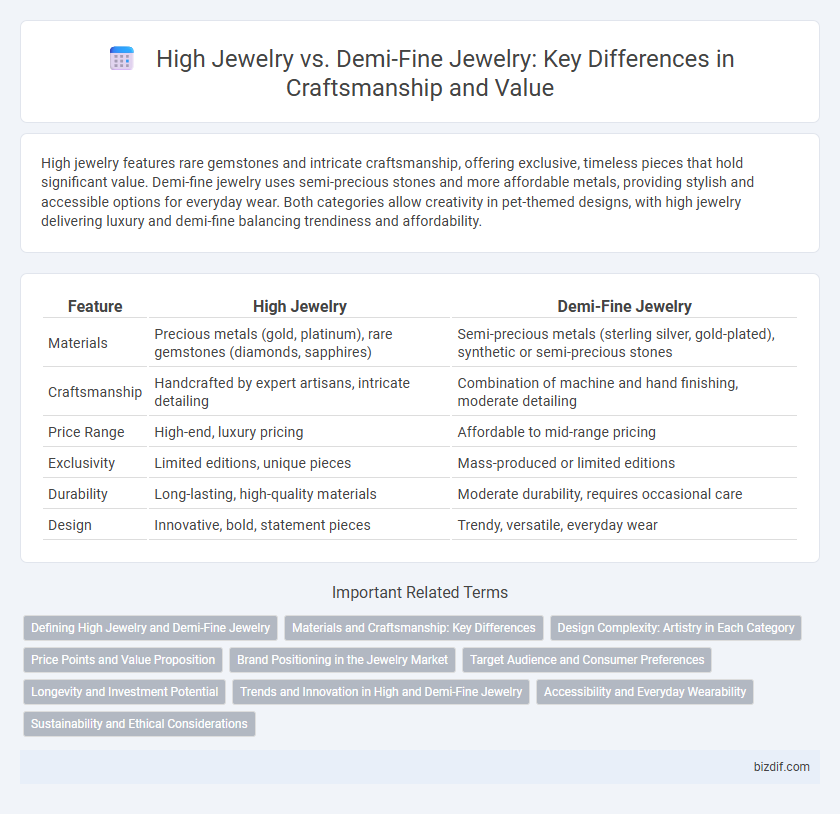High jewelry features rare gemstones and intricate craftsmanship, offering exclusive, timeless pieces that hold significant value. Demi-fine jewelry uses semi-precious stones and more affordable metals, providing stylish and accessible options for everyday wear. Both categories allow creativity in pet-themed designs, with high jewelry delivering luxury and demi-fine balancing trendiness and affordability.
Table of Comparison
| Feature | High Jewelry | Demi-Fine Jewelry |
|---|---|---|
| Materials | Precious metals (gold, platinum), rare gemstones (diamonds, sapphires) | Semi-precious metals (sterling silver, gold-plated), synthetic or semi-precious stones |
| Craftsmanship | Handcrafted by expert artisans, intricate detailing | Combination of machine and hand finishing, moderate detailing |
| Price Range | High-end, luxury pricing | Affordable to mid-range pricing |
| Exclusivity | Limited editions, unique pieces | Mass-produced or limited editions |
| Durability | Long-lasting, high-quality materials | Moderate durability, requires occasional care |
| Design | Innovative, bold, statement pieces | Trendy, versatile, everyday wear |
Defining High Jewelry and Demi-Fine Jewelry
High jewelry epitomizes exceptional craftsmanship, often featuring rare gemstones and precious metals like platinum or 18k gold, designed for exclusivity and long-term value. Demi-fine jewelry combines accessible luxury with quality materials such as gold vermeil and semi-precious stones, offering stylish yet affordable alternatives to high-end pieces. Both categories emphasize artistry but differ significantly in pricing, materials, and target audiences.
Materials and Craftsmanship: Key Differences
High jewelry features rare gemstones and precious metals like platinum and 18k gold, crafted by highly skilled artisans using intricate techniques that ensure exceptional quality and exclusivity. Demi-fine jewelry combines lower karat gold or sterling silver with semi-precious stones, emphasizing accessibility while maintaining good craftsmanship. The key difference lies in the rarity and durability of materials alongside the complexity of workmanship, making high jewelry a luxury investment versus demi-fine's trendy and affordable appeal.
Design Complexity: Artistry in Each Category
High jewelry features intricate design complexity, showcasing exceptional craftsmanship with rare gemstones and elaborate settings that emphasize uniqueness and artistic expression. Demi-fine jewelry balances creativity with accessibility, using semi-precious stones and simpler designs that maintain elegance while appealing to everyday wear. Both categories highlight artistry, but high jewelry prioritizes detailed luxury, whereas demi-fine focuses on versatile, stylish design.
Price Points and Value Proposition
High jewelry commands premium price points due to exceptional craftsmanship, rare gemstones, and exclusive designs, offering unparalleled value as investment pieces and heirlooms. Demi-fine jewelry provides more affordable options crafted with semi-precious stones and durable metals like gold vermeil or sterling silver, balancing quality and style suitable for everyday wear. The value proposition of demi-fine lies in accessible luxury and versatility, whereas high jewelry appeals to collectors seeking exclusivity and long-term asset appreciation.
Brand Positioning in the Jewelry Market
High jewelry occupies the luxury segment, characterized by exceptional craftsmanship, rare gemstones, and exclusivity, catering to affluent clientele and enhancing brand prestige. Demi-fine jewelry targets a broader market with accessible price points, utilizing high-quality materials like gold vermeil and semi-precious stones to balance affordability and elegance. Brands position high jewelry as timeless investment pieces while demi-fine serves fashion-conscious consumers seeking stylish, everyday luxury.
Target Audience and Consumer Preferences
High jewelry targets affluent collectors seeking exclusive, handcrafted pieces with rare gemstones and exceptional craftsmanship, valuing legacy and artistry over price. Demi-fine jewelry appeals to fashion-conscious consumers prioritizing affordable luxury, trend-driven designs, and everyday wearability without compromising style. Understanding these distinct customer profiles helps brands tailor marketing strategies and product offerings to meet diverse consumer preferences effectively.
Longevity and Investment Potential
High jewelry pieces, crafted from precious metals and gemstones, offer exceptional longevity due to superior materials and artisanal craftsmanship, making them valuable investment assets that often appreciate over time. Demi-fine jewelry, composed of gold-plated metals and semi-precious stones, provides stylish affordability but lacks the durability and significant resale value characteristic of high jewelry. Collectors and investors prioritize high jewelry for its enduring quality and potential to retain or increase market value in the luxury jewelry sector.
Trends and Innovation in High and Demi-Fine Jewelry
High jewelry trends emphasize exclusive craftsmanship, rare gemstones, and innovative design techniques such as intricate hand engraving and advanced setting methods. Demi-fine jewelry integrates contemporary materials like mixed metals and ethically sourced stones, appealing to younger consumers seeking affordability paired with unique, trend-driven aesthetics. Innovations in both categories include customization through 3D printing and augmented reality for virtual try-ons, enhancing personalization and consumer engagement.
Accessibility and Everyday Wearability
High jewelry pieces are crafted with rare gemstones and precious metals, making them exclusive and often reserved for special occasions. Demi-fine jewelry offers a more accessible price point with quality materials like gold-plated silver and semi-precious stones, suitable for daily wear. This balance allows demi-fine collections to cater to consumers seeking stylish, durable pieces for everyday use without compromising aesthetic appeal.
Sustainability and Ethical Considerations
High jewelry often utilizes rare gemstones and precious metals sourced through stringent ethical mining practices, ensuring environmental sustainability and fair labor conditions. Demi-fine jewelry prioritizes recycled materials and lab-grown stones, reducing the ecological footprint and promoting responsible sourcing. Both categories increasingly emphasize transparency and traceability in their supply chains to meet growing consumer demand for sustainable and ethical luxury.
High jewelry vs Demi-fine Infographic

 bizdif.com
bizdif.com